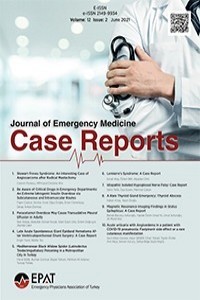Syncope in a Young Man
Syncope in a Young Man
___
- 1. Brugada P, Brugada J. Right bundle branch block, persistent ST segment elevation and sudden cardiac death: a distinct clinical and electrocardiographic syndrome. A multicenter report. J Am Coll Cardiol 1992; 20: 1391-6. [CrossRef ]
- 2. Chen Q, Kirsch GE, Zhang DM, Brugada R, Brugada J, Brugada P, et al. Genetic basis and molecular mechanism for idiopathic ventricular fibrillation. Nature. 1998; 392; 293-6. [CrossRef ]
- 3. Benito B, Sarkozy A, Mont L, Henkens S, Bernuezo A, Tamborero D, et al. Gender differences in clinical manifestations of Brugada syndrome. J Am Coll Cardiol 2008; 52: 1567-73. [CrossRef ]
- 4. Brugada J, Brugada R, Brugada P. Determinants of sudden cardiac death in individuals with the electrographic pattern of Brugada syndrome and no previous cardiac arrest. Circulation 2003; 108: 3092-6. [CrossRef ]
- 5. Brugada P, Benito B, Brugada R, Brugada J. Brugada Syndrome: Update 2009. Hellenic J Cardiol 2009; 50: 352-72.
- 6. Antzelevitch C, Brugada P, Borggrefe M, Brugada J, Brugada R, Corredo D, et al. Brugada syndrome: report of the second consensus conference: endorsed by the Heart Rhythm Society and the European Heart Rhythm Association. Circulation 2005; 111: 659-70. [CrossRef ]
- 7. Priori SG, Napolitano C, Gasparini M, Pappone C, Della Bella P, Giordano U, et al. Natural history of Brugada syndrome: insights for risk stratification and management. Circulation 2002; 105: 1342 -7. [CrossRef ]
- 8. Hirata K, Takagi Y, Nakada M, Kyushima M, Asato H. Beat to beat variation of the ST segment in a patient with right bundle branch block, persistent ST segment elevation, and ventricular fibrillations: a case report. Angiology 1998; 48: 87-90. [CrossRef ]
- 9. Veltmann C, Schimpf R, Echternach C, Eckardt L, Kuschy J, Streitner F, et al. A prospective study on spontaneous fluctuations between diagnostic and non-diagnostic ECGs in Brugada syndrome: implications for correct phenotyping and risk stratification. Eur Heart J 2006; 27: 2544- 52. [CrossRef ]
- 10. Kusano KF, Taniyama M, Nakamura K, Miura D, Banba K, Nagase S, et al. Atrial fibrillation in patients with Brugada syndrome relationships of gene mutation, electrophysiology, and clinical backgrounds. J Am Coll Cardiol 2008; 51:1169-75. [CrossRef ]
- 11. Available from: http://www.brugadadrugs.org
- 12. Brugada J, Brugada R, Antzelevitch C, Towbin J, Nademanee K, Brugada P. Long term follow-up of individuals with the electrocardiographic pattern of right bundle-branch block and ST-segment elevation in precordial leads V1-V3. Circulation 2002; 105: 73-8. [CrossRef ]
- 13. Sacher F, Probst V, Maury A, Babuty D, Mansourati J, Komatsu Y, et al. Outcome after implantation of a cardioverter-defibrillator in patients with Brugada syndrome: a multicenter study. Circulation 2006; 114: 2317-24. [CrossRef ]
- 14. Priori SG, Blomstrom-Lundqvist C, Mazzanti A, Blom N, Borggrefe M, Camm J, et al. 2015 ESC Guidelines for the management of patients with ventricular arrhythmias and the prevention of sudden cardiac death: The Task Force for the Management of Patients with Ventricular Arrhythmias and the Prevention of Sudden Cardiac Death of the European Society of Cardiology (ESC). Endorsed by: Association for European Paediatric and Congenital Cardiology (AEPC). Eur Heart J 2015; 36: 1793-867. [CrossRef ]
- 15. Ohgo T, Okamura H, Noda T, Satomi K, Suyama K, Kurita T, et al. Acute and chronicmanagement in patients with Brugada syndrome associated with electrical storm of ventricular fibrillation. Heart Rhythm 2007; 4: 695-700. [CrossRef ]
- 16. Shen WK, Sheldon RS, Benditt DG, Mitchell IC, Forman DE, Goldberger ZD, et al. 2017 ACC/AHA/HRS Guideline for the Evaluation and Management of Patients with Syncope: A Report of the American College of Cardiology/American Heart Association Task Force on Clinical Practice Guidelines, and the Heart Rhythm Society. Circulation 2017; 136: e60- e122. [CrossRef ]
- Yayın Aralığı: 4
- Başlangıç: 2010
- Yayıncı: Alpay Azap
Estelle Mei Chen CHNG, Eeling GOH
Tubal Ectopic Pregnancy 12 Weeks after Laparoscopic Supracervical Hysterectomy and Tubal Ligation
Methimazole-Induced Febrile Neutropenia
Behçet VARIŞLI, Sinan YILDIRIM, Şehnaz PAKER, Hatice KARAÇAM
Chilaiditi Syndrome: A Rare Cause of Shortness of Breath and Abdominal Pain
Muhammet Gökhan TURTAY, Şükrü GÜRBÜZ, Serdar DERYA, Hakan OĞUZTÜRK, Muhammed EKMEKYAPAR
Ali EZER, Nezih AKKAPULU, Alper PARLAKGÜMÜŞ
A Junctional Rhythm Caused by Administration of Intravenous Phenytoin
Hüseyin NARCI, İbrahim TOKER, Güllü AKBAYDOĞAN DÜNDAR, Cüneyt AYRIK
A Case of a Baby Care-Related Accident: Hair-Thread Tourniquet Syndrome
Erdem Yunus UYMUR, Ahmet KÖSE, Murat TOPAL, Recep DİNÇER, Mehmet Fatih GÜZEL
